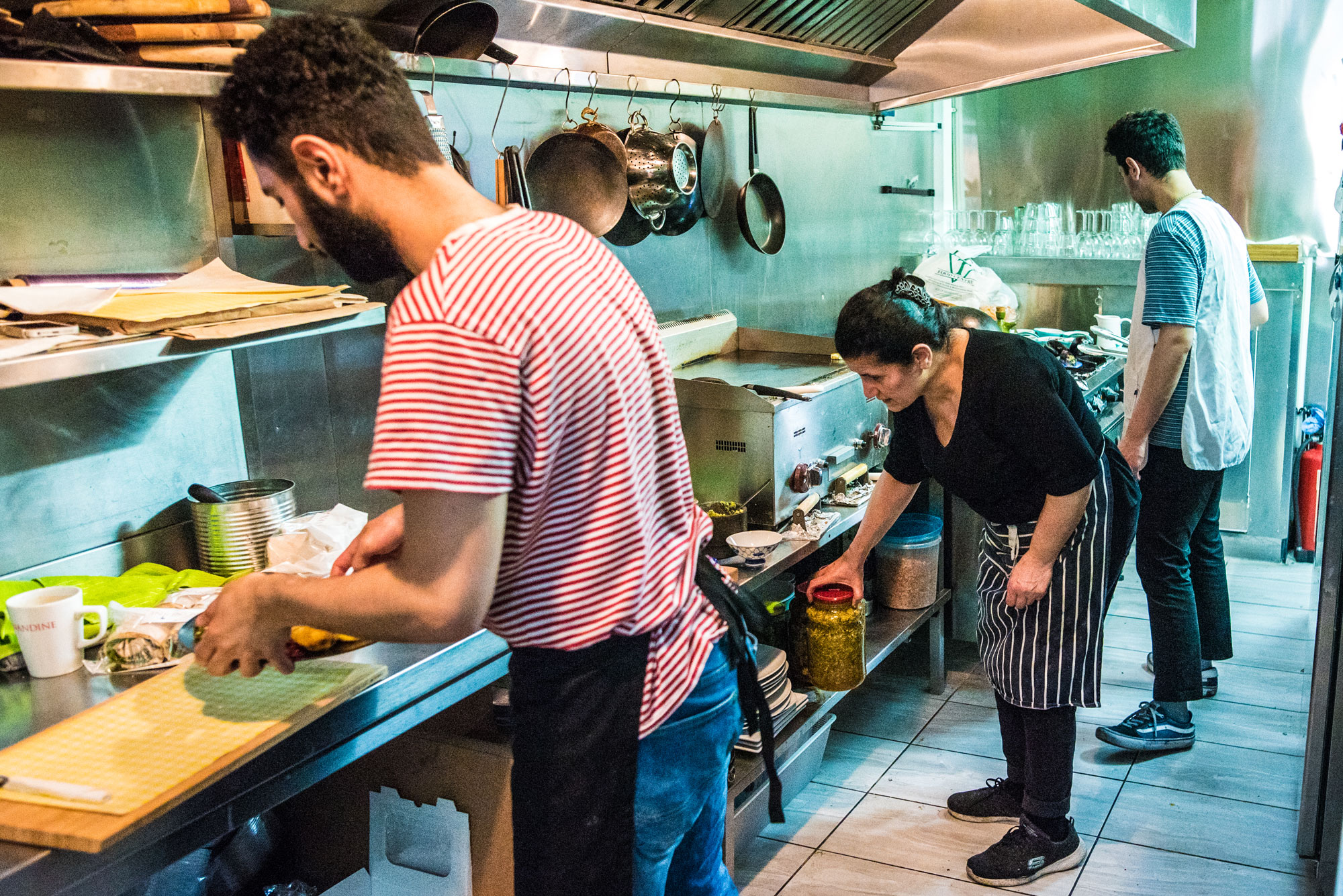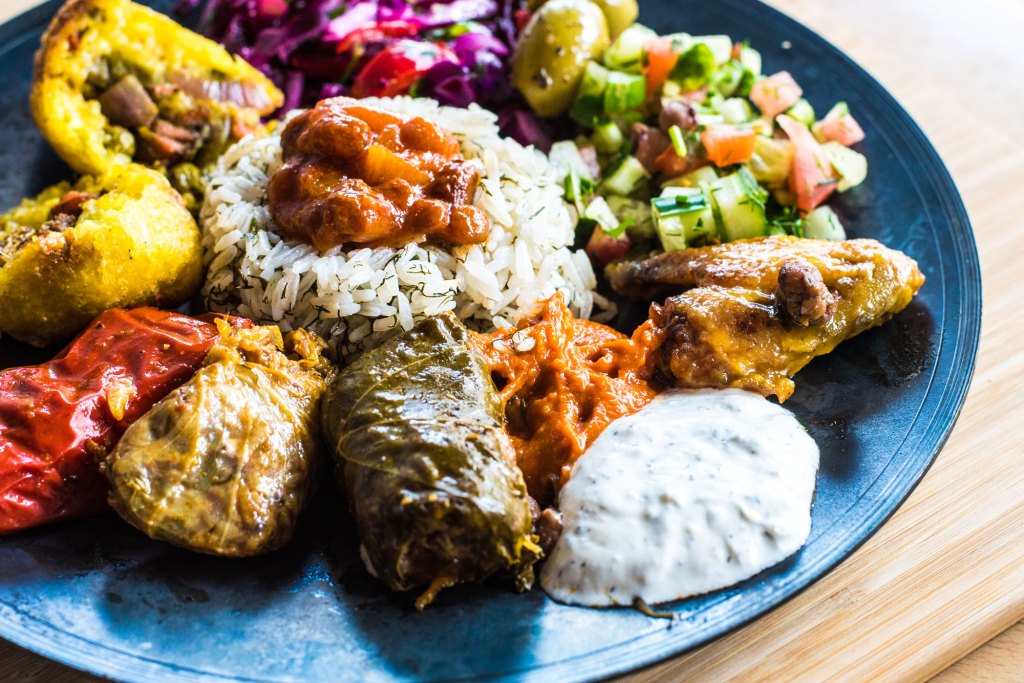Two young men are standing at the counter of Nandine, a small cafe/restaurant in South London. They’re grilling co-manager Rang Baban about his menu.
“Is it Lebanese?” one of them asks.
Videos by VICE
“Is it rice?” says his friend. “Like Middle Eastern?”
Rang smiles. He has fielded these questions many, many times before.
“It’s like nothing you’ve ever tried before,” he says.
Nandine is a Kurdish eatery. More specific than just “Middle Eastern,” it celebrates the food of Kurdistan, a region that covers parts of Turkey, Iraq, Iran, Armenia, and Syria. Because of the disjointed placement of its population, Kurdish cuisine is hugely varied, incorporating recognisable West Asian ingredients like dates and lamb—but also unexpected ruptures of flavour from dill, celery, and apricot.
So, yeah, probably unlike anything you’ve ever tried before.

“We’re doing this to promote Kurdish identity and food,” Rang explains, joining me at a table after the two curious customers opt for sujuk sausage sandwiches. “Whatever turmoil we’re going through right now, there are good points: food being one of them, art being another.”
Sadly, turmoil runs through much of Kurdistan’s history. Despite being the fourth largest ethnic group in the Middle East, the Kurds do not have a permanent independent nation of their own. Since the defeat of the Ottoman Empire following World War One, when the Western allies made no provision for the creation of a Kurdish state, Kurds have been a minority in their respective countries and many attempts to assert independence have ended in violence.
These troubles feel a long way from Nandine, which sits on a quiet residential street not far from the bustle of rapidly gentrifying Peckham. At the weekends, it serves mexlama (similar to shakshuka) and sweet eggy dates; za’atar chicken wraps at lunch; and colourful mezze platters overflowing with dolma, stuffed rice cakes, homemade chili jam, and tamarind meatballs in the evenings.

Rang opened the restaurant last year with brother Raman Baban (fellow co-manager), dad Pola Baban (business advisor and handyman—he fitted the gleaming metro tiles around the counter), and mum Pary, who is head chef. She joins us from the kitchen, where she has just prepared falafel for a woman and her two granddaughters. The girls point excitedly at the pistachio-flecked baklava in the counter’s display case before settling to eat lunch at the window seat, lounging on benches Pola made from reclaimed pallet wood.
“I love cooking and I always wanted to do different stuff, to know more,” Pary says, joining us at the table from the kitchen. “Kurdish food has got lots of different types of cuisine because each tribe has its own cuisine. When you think about it, it’s all the same but different because we are all from a different part of Kurdistan, and everyone is putting their own flavour, their own spices, their own thing into it. It makes it really interesting.”
Pary was forced to leave Qaladze, a town in what is today considered to be part of Iraqi Kurdistan, in 1989 after it was attacked by forces from Iraq. Stopping at towns and villages as she travelled across the region to find safety, Pary discovered different styles of Kurdish cooking. Some of the villagers she ate with would season their dishes using bunches of herbs grabbed fresh from the ground. Others cooked lamb in huge ovens over the fire in a way she had never seen before. Pary wrote their recipes down in a notebook that she still keeps in the Nandine kitchen.
“She was a kid,” Rang says. “How old were you? Nineteen?”
“Eighteen or 19,” Pary replies. “I passed my A Levels so was going to university but it was May 1989, so I couldn’t do the test. I had to flee. I learned a lot and that’s what made me love food because everybody from East Kurdistan to South Kurdistan was different. They used lots of wild herbs, lots of different spices, berries, and things they’d grind and put in.”
Pary first met husband Pola in East Kurdistan, a year after fleeing Qaladze. The couple married and travelled to the UK in 1995, settling in South London, where they raised sons Rang and Ramat. Three years later, Pary and Pola opened a newsagents near Elephant and Castle Underground station. With the boys in primary school, the days were long and busy, but Pary made time to continue her education.

“I always helped him [Pola, at the newsagents] because the money wasn’t enough to pay someone to work for you,” she remembers. “So, I was always working with him and going and taking the kids to school. Then I’d go there and help him and he’d go to the cash-and-carry. I loved hairdressing, so whenever my husband had time, if somebody was there helping, I was sneaking to the college. I did computer courses, I did English courses, I did beauty courses. And then I started doing hairdressing NVQ Level 1 and 2.”
“She would take us to primary school which was right next to the kiosk, we’d go extra early,” adds Rang. “And then she’d come back in and go to the kiosk and work there, and then afterwards when my dad would come back from getting stock, she’d pick us up from school and we’d all stay there [at the kiosk] until 8 in the night.”
“I was tired but it’s what I wanted,” Pary says, as Rang looks on proudly. “It’s not everyday that opportunities come to you. I love to learn, I love to educate myself in any way.”
Around 2008, Pary began thinking about ways to grow the family’s business. Located near the Underground station, as well as London College of Communication and a shopping centre, their newsagents was in the perfect location to sell takeaway lunches.
“I told my husband that we should put a sandwich kiosk in [next to their newsagents]. He said, ‘No, it’s too much work, we can’t do that.’ But I persuaded him. We [thought about] contacting some company for the sandwiches but by the second day, they won’t taste good and people won’t buy them and there would be too much mayonnaise in there, so I said, ‘That’s it. We have to do something about the sandwiches.’ We applied with the council, so they agreed. It took four years but in the end, they gave me the space [to sell sandwiches in the kiosk].”
Pary set about making the sandwiches herself, starting with stir-fried spinach and egg chaat.
“People loved it and then I put it in a wrap and toasted it and cut it in half,” she says. “That one went too.”

The family still runs the newsagents and next-door sandwich kiosk, and the passion for cooking that Pary honed there inspired them to open Nandine. At first, they used the space as a prep kitchen for the kiosk, then they opened it as a cafe selling basic cold food. Over the last year, it has evolved into what it is today: a Kurdish cafe-stroke-restaurant.
“We opened and we had nothing in here, we had muffins,” laughs Rangs. “Muffins and Victoria sponge cakes and what have you. My mum would make some of those and some would come from bakeries who supplied us, but it’s not what we wanted. We decided it’s best to go our own way and do an evening menu as well.”
The family see the food at Nandine as a modern representation of Kurdish cuisine. Traditional dishes like stuffed rice cakes with mince and yogurt sauce are all there, but Pary has adapted some of the recipes from her notebook to make better use of vegetables and dairy-free alternatives. Nandine’s Instagram bio proudly declares: “Mum loves vegans.”
“It’s the same [as traditional Kurdish food] but in a healthier way because back home, we have got milk, butter, yogurt, and things like that,” Pary explains. “But here, we try and go for lots of non-dairy too. It’s very healthy, we don’t use lots of oil and ghee.”

“I think in Kurdistan, food is very oily because the ingredients are so simple,” Rang points out. “They need to make it as tasty as possible by adding loads of salt or random spices that don’t work well together. We’re just refining that in a sense, simplifying it, making it taste even better by being simpler.”
Apart from a handful of kebab shops on Edgeware Road that Rang says “still have that Kurdish vibe, as if you’re stepping into a shop in Kurdistan where the people are really rough and weird” and Yada’s, a nearby Kurdish restaurant owned by Pary’s nephew, Nandine is one of the few places in London specialising in Kurdish food.
Rang points to some of the ingredients that make the cuisine unique.
“Kurdish food does rely on dill and celery but there are certain foods that Arabs and Iranians and Turks use in their food, and that’s what distinguishes Kurdish food from them,” he says. “That’s what we kind of focus on, stuff like purslane—no one knows about it. It’s a plant, it’s quite citrusy.”
Pary chips in: “It has everything, it’s like aloe vera, it’s full of collagen, it has lots of health benefits. We put it on salad, we make a stew with it.”

Rang brings out one of their famed mezze plates for me to try. It’s a kaleidoscope of fat dolma, muhammara, and fragrant falafel nestled around a mound of apricot-topped rice. I also try the baklava, some of it decorated with rose petals that the family import specially from Kurdistan.
“The end goal for us is to promote Kurdish identity and make it work for Kurds,” says Rang. “There’s not enough Kurdish food places.”
This is what keeps the Baban family going. Rang admits that running a food business with multiple locations is hard and licensing problems with the council have slowed down some of their progress at the cafe (none of them have slept much recently), but they’re determined to bring Kurdish food to a wider audience. Last year, Nandine was selected for one of the coveted food trader spots at multi-story-car-park-turned-arts-space Peckham Levels, which opened in December.

“Peckham Levels was an accident!” Rang insists. “I applied for it just for coffee and nothing else, no food.”
But Peckham Levels were interested in the family’s food and organised to visit Nandine for a tasting. Rang remembers how nervous he, his brother, and Pary were before presenting their dishes.
“We created the menu and they tasted the food and we’d never done a food tasting before. The sujuk sandwich we hadn’t made before ourselves. It was food that we cooked at home—the seven spice chicken, the dolma. One of the guys from Peckham Levels was one of mum’s customers at the Elephant and Castle kiosk, he was a technician at the London College of Communication at the time.”

It must have been a fond memory. The Peckham Levels team immediately invited Nandine to join the space and they served their first customers there shortly after it opened.
Towards the end of our interview, Rang tells me he sees “two futures” for Nandine. One is for their current cafe/restaurant on the quiet street to focus on mezze platters and brunches. The second is for the Peckham Levels space, which he wants to specialise in Kurdish food-to-go. Pary, meanwhile, is happy to continue cooking and learning.
“We have so many different foods, things that people don’t make any more,” she says. “I want to bring it back in new ways.”




